If you’re dreaming of a succulent collection that includes every color in the rainbow, don’t forget about the color orange. These eye-catching orange succulents are perfect for adding a splash of vibrant color to your garden. Whether you’re interested in cacti or succulents, you’re sure to find the sunset-hued plant of your dreams on this list.
Orange succulents are such a contrast to the normal greens and blues of most succulents. In this blog, you’ll be introduced to over X species that have unique reactions to stress that allow them to turn an orange color. Very few succulents are constantly orange, and some succulents are included in this list due to orange blooms. Get ready for vibrant orange succulents!
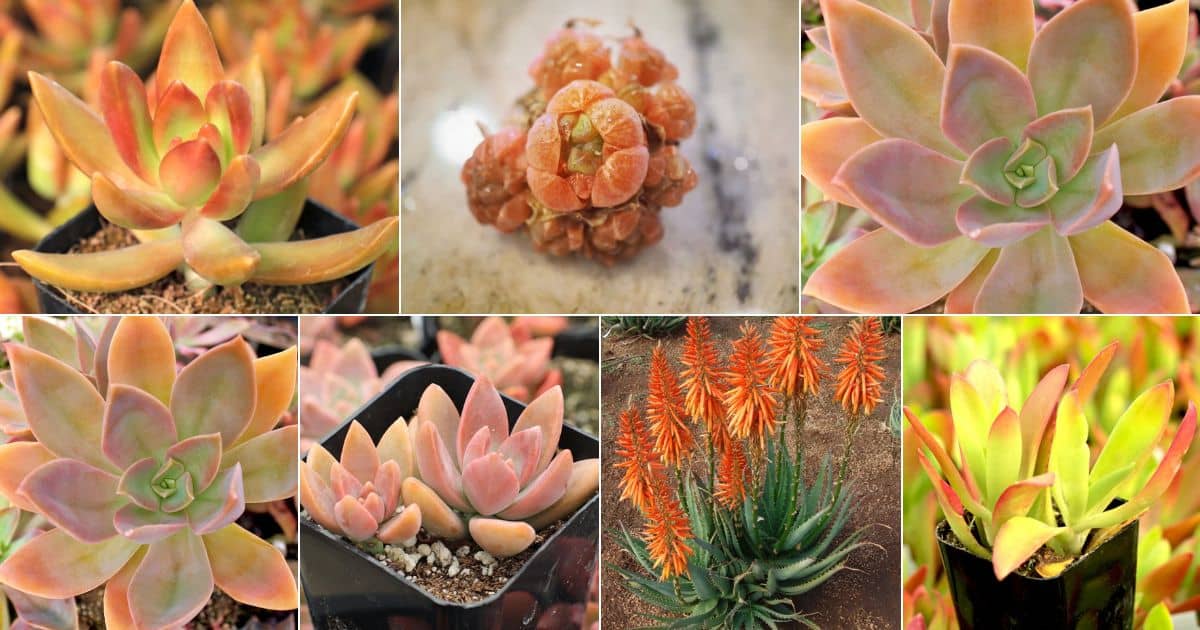
Jump to:
- Echeveria ‘Sanyatwe’
- Graptosedum ‘California Sunset’
- Mammillaria elongata cristata ‘Copper King’
- Opuntia rufida minima ‘Mini Cinnamon Cactus’
- Sedum adolphii ‘Golden Sedum’
- Lithops karasmontana ‘Orange Ice’
- Graptoveria ‘Fred Ives’
- Echeveria ‘Orange Monroe’
- Sedum nussbaumerianum ‘Coppertone Stonecrop’
- Schlumbergera gaertneri – Colomba or Orange Easter Cactus
- Echeveria Agavoides – orange ebony
- Haworthia obtusa - Orange
- Graptosedum Francesco Baldi
- Euphorbia Tirucalli - “Sticks on Fire”
- Echeveria “Snow Angel"
- Optuna phaeacantha hybrid - Orange Princess
- Crassula capitella - Campfire Crassula
- Echeveria - Orange Dream
- Haworthia bayeri SP Orange
- Aloe Dorothea – Sunset Aloe
- Echinopsis chamaecereus - Peanut cactus
- Delosperma granita® - Orange Ice Plant
- Kalanchoe blossfeldiana – Orange
- Graptopetalum mendozae – Ghost Plant
- Aloe – Safari Orange
Echeveria ‘Sanyatwe’
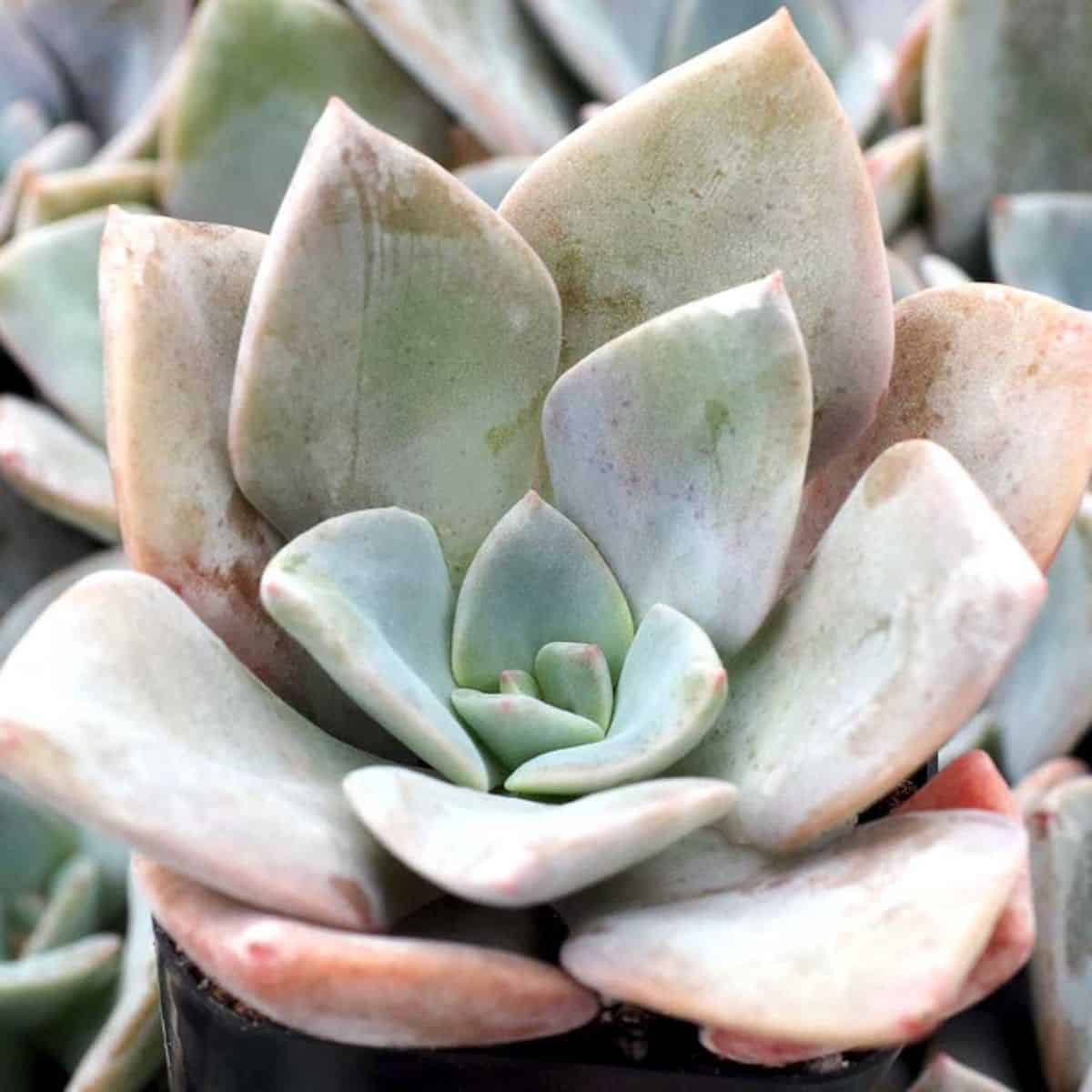
Buy it from:
The Sanyatwe is an interesting little succulent with thick, peachy-orange leaves arranged in a rosette pattern. The rosettes can grow up to six inches in diameter and the entire plant can reach up to eight inches in height. The Sanyatwe is a great way to add a splash of color to any succulent garden.
Like most varieties of Echeveria, Sanyatwe are easy to care for. They prefer partial sunlight and properly draining soil. They are not frost tolerant, but they can handle draught. They are known to have rather fragile leaves, so take care when handling them.
Read Also: 11 Best Cold Hardy Succulents
Graptosedum ‘California Sunset’
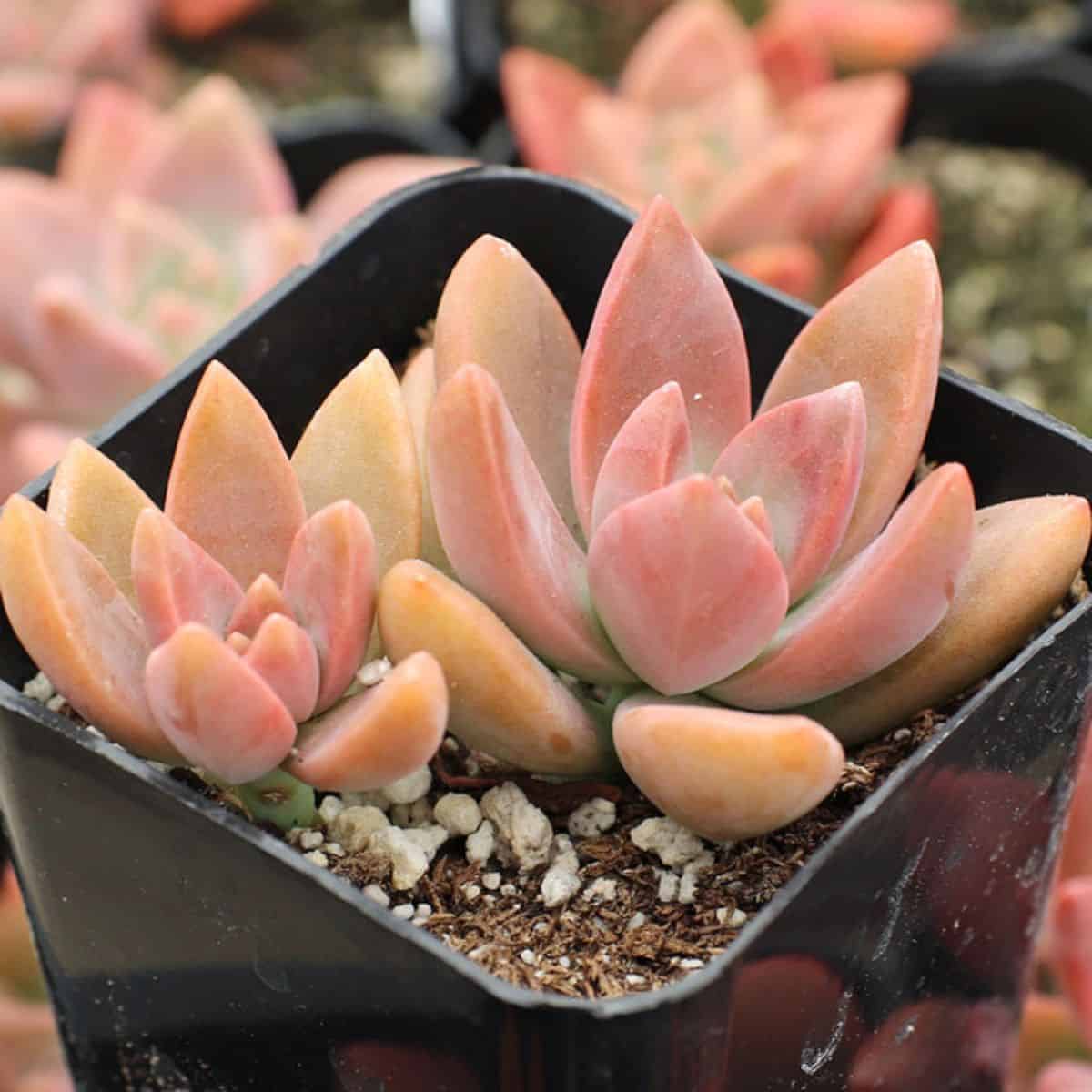
Buy it from:
This adorable hybrid succulent is a cross between Graptopetalum paraguayense and Sedum adolphi. Its vibrant leaves are orange with a slightly pink hue. Interestingly, new growth will appear to be greyish-green and will develop its distinctive orange hue over time.
California Sunsets are easy to care for and propagate. They prefer partial sun, well-draining soil, and proper watering techniques. They can be propagated from seeds, cuttings, or offsets. They are an excellent plant for experienced and inexperienced gardeners alike.
Read Also: 11 Pretty Pink Succulents
Mammillaria elongata cristata ‘Copper King’
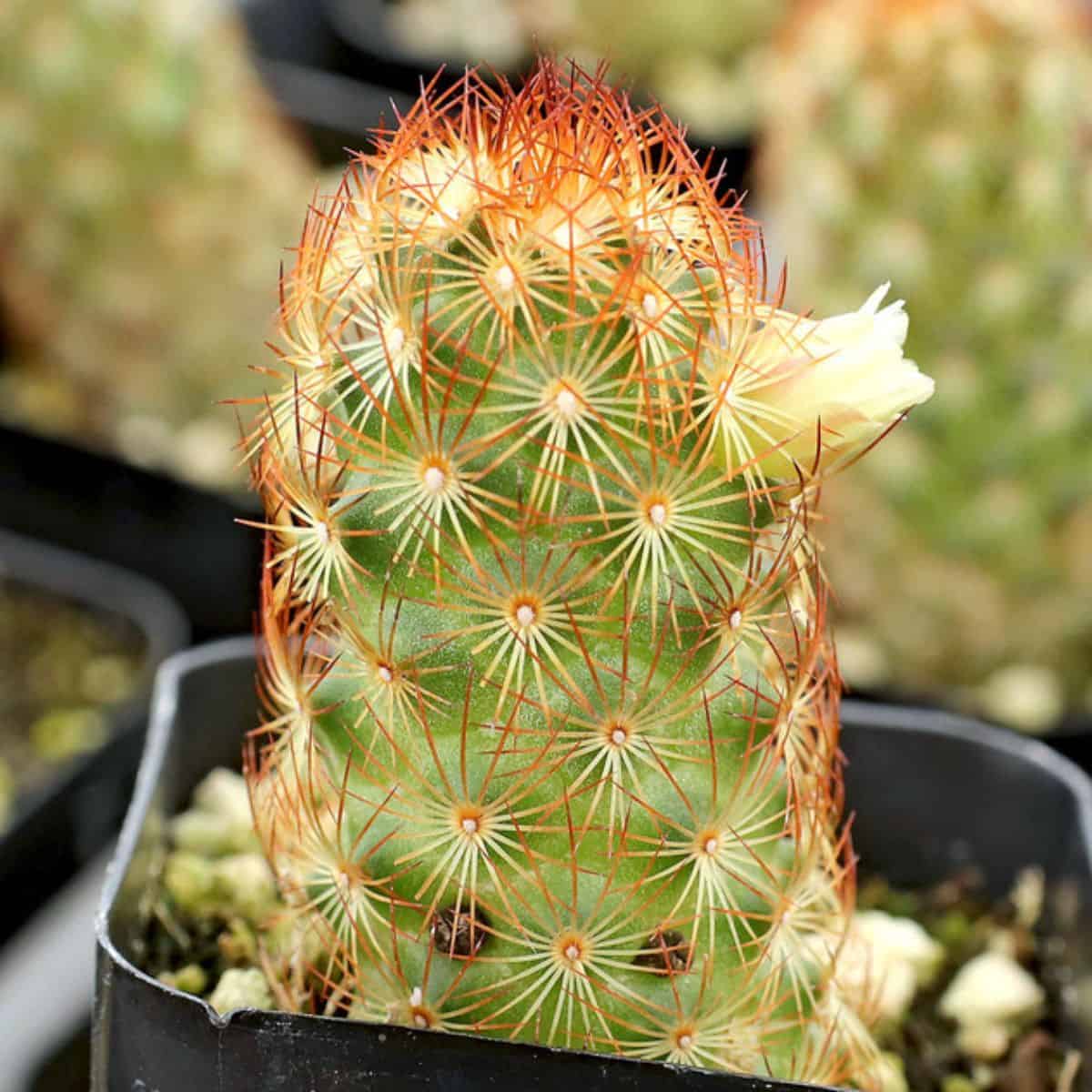
Buy it from:
The Copper King is a cactus native to central Mexico that grows in tight, dense clumps. It’s perfect for ground cover but it does grow rather slowly. Its bright green stems, which can grow up to eight inches tall, are covered in the coppery-orange spines that give the plant its nickname. It blooms in the Spring and produces pale yellow or white flowers.
No products found.
The Copper King thrives in full sun with properly draining soil. It prefers only occasional watering from Spring to Fall, with little to no water during the winter. It’s quite sensitive to frost and must be protected during particularly cold weather.
Read Related Topic: 9 Vibrant Purple Succulents
Opuntia rufida minima ‘Mini Cinnamon Cactus’
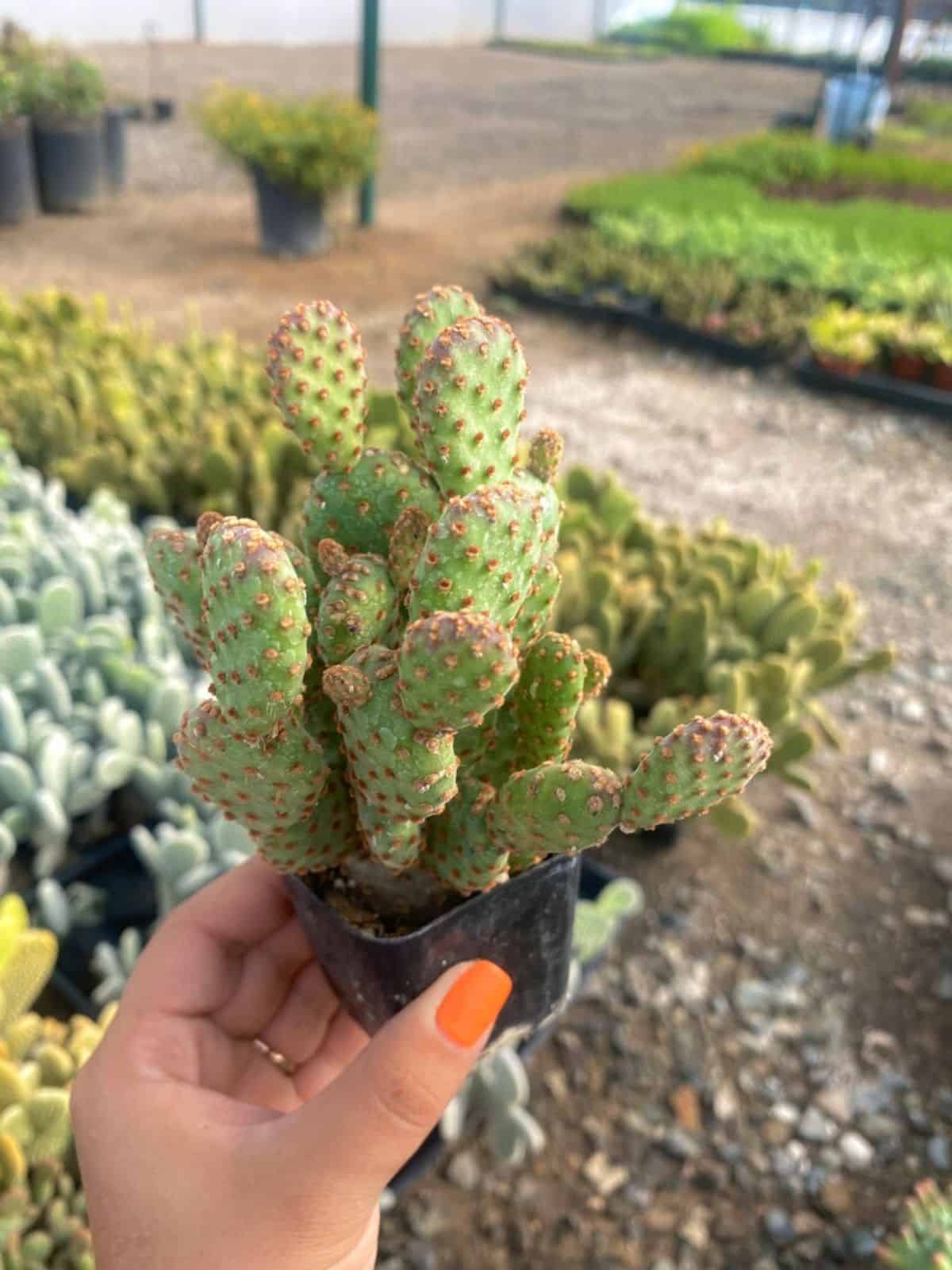
Buy it from:
This petite Prickly Pear Cactus only grows up to about ten inches in height. It’s native to Texas and gets the nickname Cinnamon Cactus from the brownish-orange spines covering its pads. In the Spring, this cactus produces flowers of varying shades of yellow.
The Mini Cinnamon Cactus does best with plenty of sunlight and adequate drainage. It’s easy to propagate, either from seeds or from pad cuttings. This cactus is not frost tolerant and is prone to root rot, so water it sparingly and protect it from colder temperatures.
Read Also: 10 Wonderful White Succulents
Sedum adolphii ‘Golden Sedum’
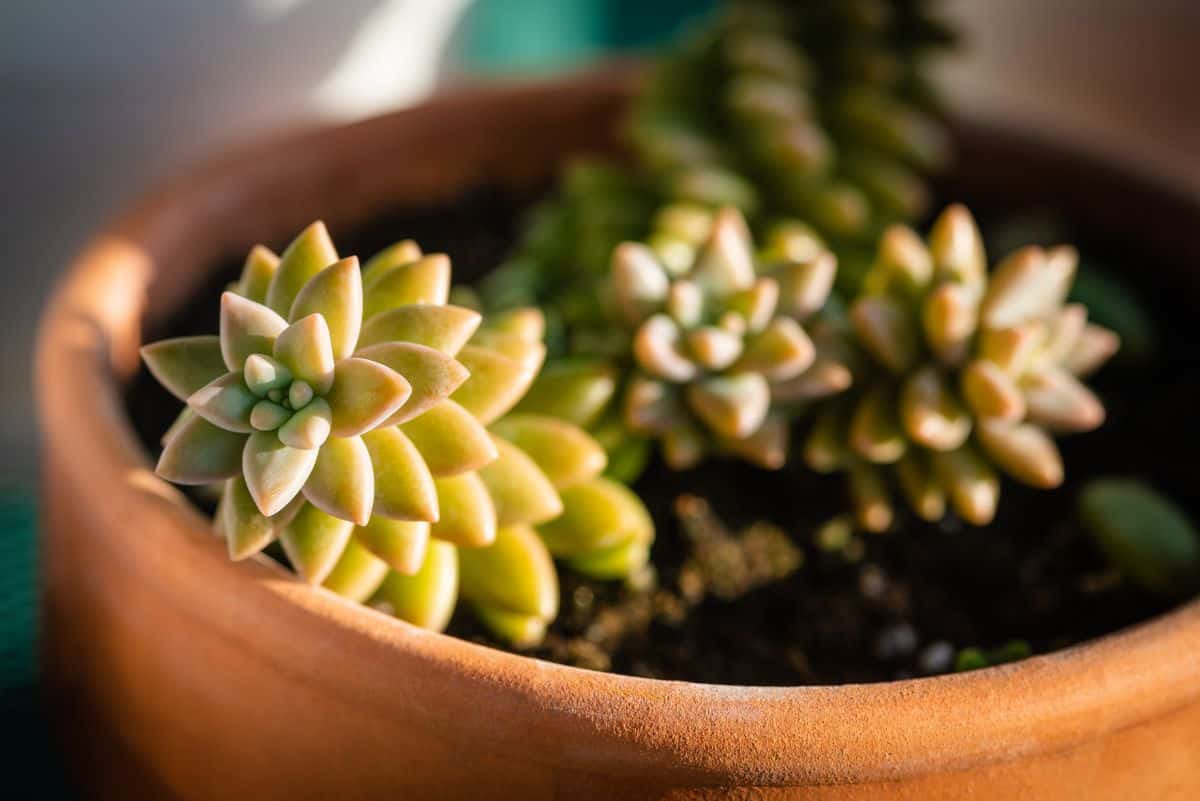
Buy it from:
Golden Sedum is a trailing succulent that is ideal as ground cover or in hanging containers. At maturity, it can reach up to ten inches in height. When grown in partial sunlight, the oblong leaves take on a yellowish-green hue. However, the leaves become a brighter and more vibrant shade of orange with more sunlight.
This spectacular succulent will do well in either partial or full sun, but it will not develop the stunning orange color it’s known for with only partial sunlight. As with most succulents, Golden Sedum prefer well-draining soil and watering only when the soil is dry.
Read Also: 5 Brilliant Black Succulents
Lithops karasmontana ‘Orange Ice’
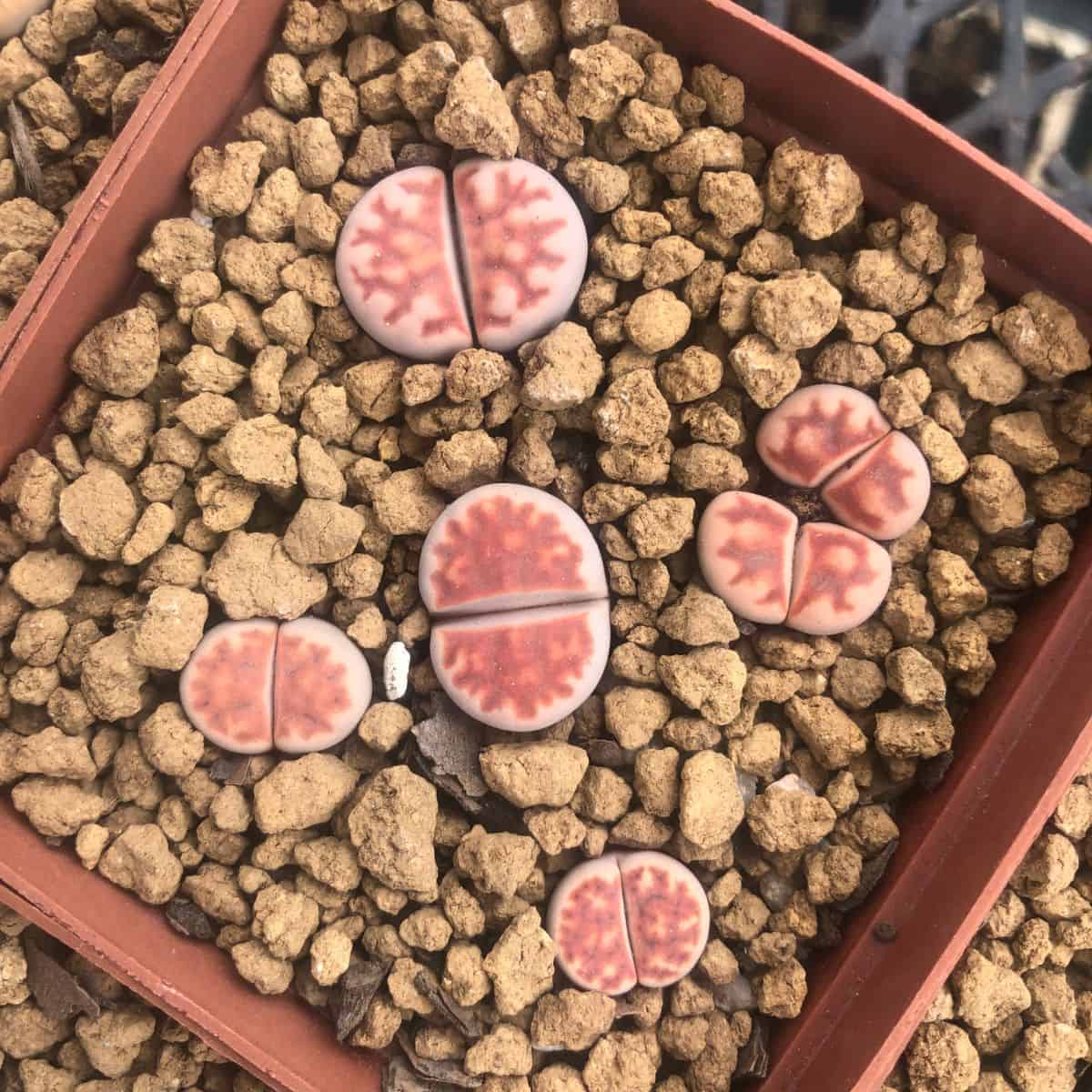
Buy it from:
This tiny succulent only measures about two inches tall at maturity. However, it grows in dense clumps which spread as the plant produces more offsets. Its chunky, nearly stemless leaves always appear in pairs and have a deep orange center. In the fall, the Lithops produces white flowers that can be nearly as big as the plant itself.
Orange Ice is a particularly slow growing succulent, so you will only need to repot it every few years. It prefers little to no water during the winter months and only infrequent watering during the rest of the year. Well-draining soil is essential to this plant’s survival. Here's our guide to Lithops care.
Graptoveria ‘Fred Ives’
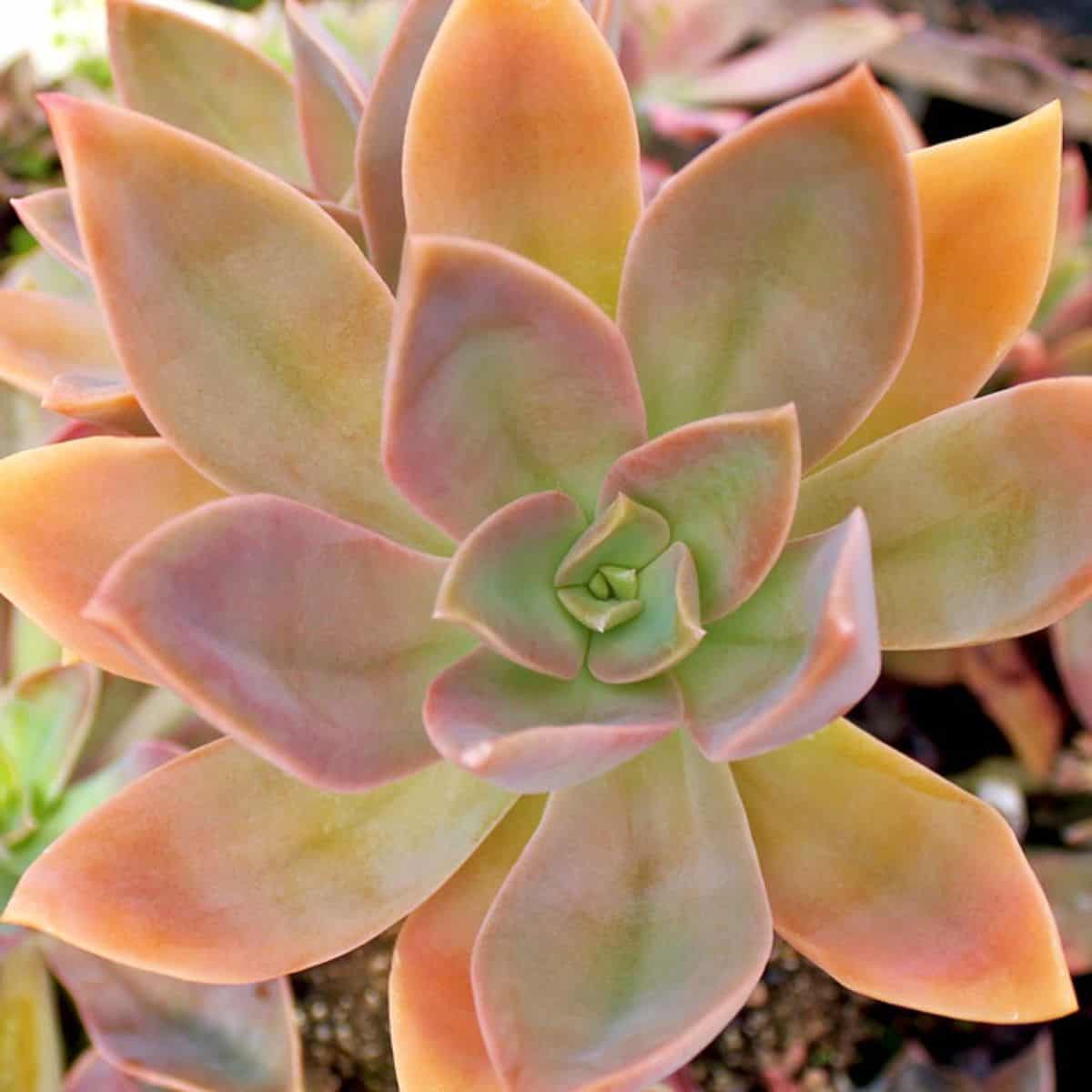
Buy it from:
A cross between Graptopetalum and Echeveria, this hybrid succulent boasts colorful leaves that range from vibrant orange to deep red and bright green. The leaves are arranged in a rosette, which can reach up to 12 inches in diameter. In ideal conditions, the plant itself can reach eight inches in height. In the summer, the plant produces a flower stalk with tiny yellow blossoms.
The Fred Ives variety of Graptoveria is an excellent plant for inexperienced gardeners. It’s easy to care for, easy to propagate, and produces new offsets quickly. It’s also non-toxic to pets, so you won’t have to worry about your furry friends.
Echeveria ‘Orange Monroe’
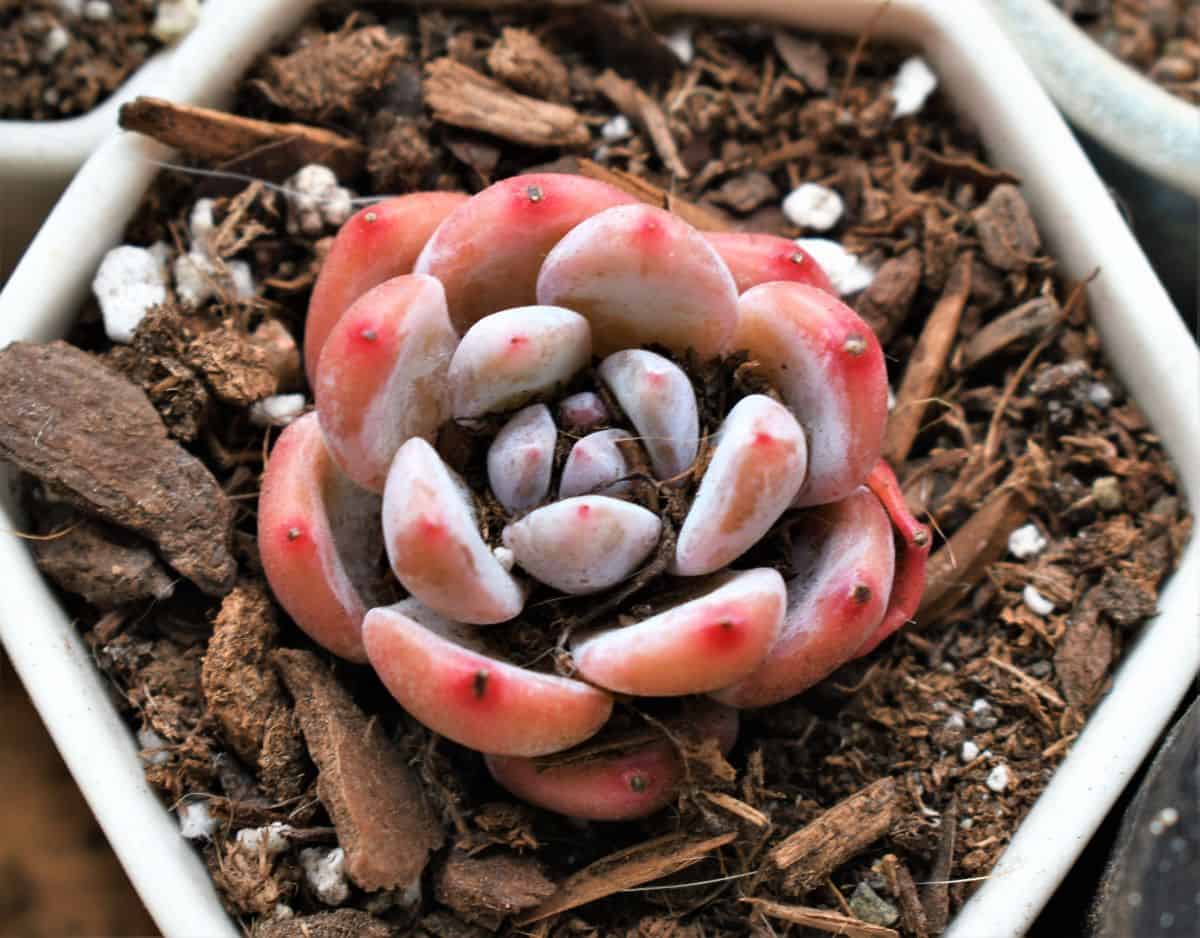
Buy it from:
The Orange Monroe boasts adorable rosettes in varying shades of green and orange. The more sun the plant receives, the brighter the orange coloring will be. The colorful leaves are arranged in a tight rosette, which can reach up to six inches in diameter.
As with other varieties of Echeveria, the Orange Monroe is easy to care for and thrives in partial sun with well-draining soil. It’s easy to propagate with leaf cuttings or offsets. In frost-free climates, the Orange Monroe makes a gorgeous addition to outdoor succulent gardens.
This is a fairly rare succulent, but you can sometimes find it on Etsy. Check it out.
Sedum nussbaumerianum ‘Coppertone Stonecrop’
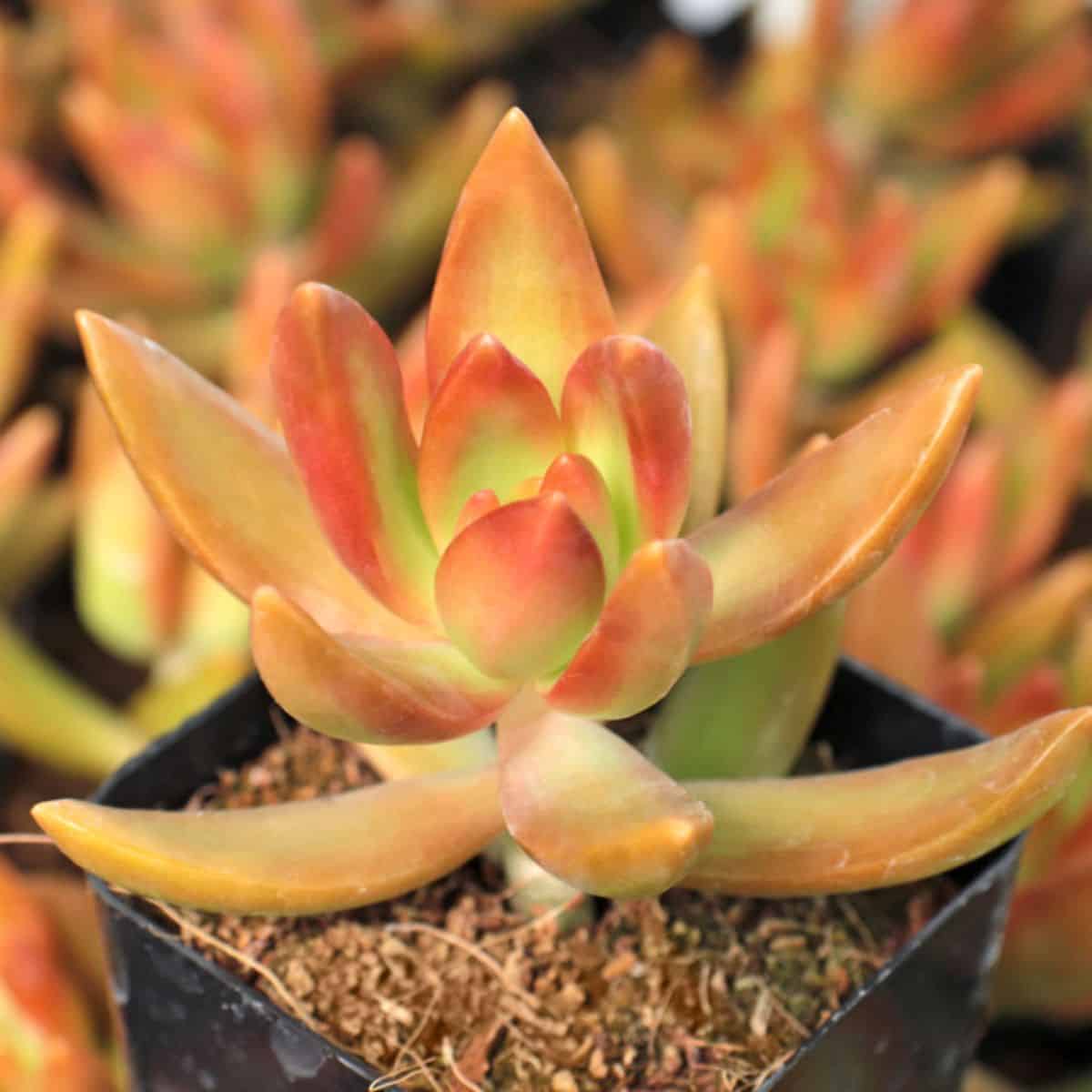
Buy it from:
Coppertone Stonecrops are an easy to care for succulent with bright orange and green leaves. Like many other orange succulents, the more sun this plant receives, the more vibrant its colors will be. In summer, round clusters of tiny, white flowers can be seen.
This beautiful succulent is best propagated through stem cuttings, which can be taken if the plant gets too leggy as it grows. It prefers full sunlight and adequately draining soil. Coppertone Stonecrop are also pet-safe, making them an excellent choice for animal lovers.
Schlumbergera gaertneri – Colomba or Orange Easter Cactus
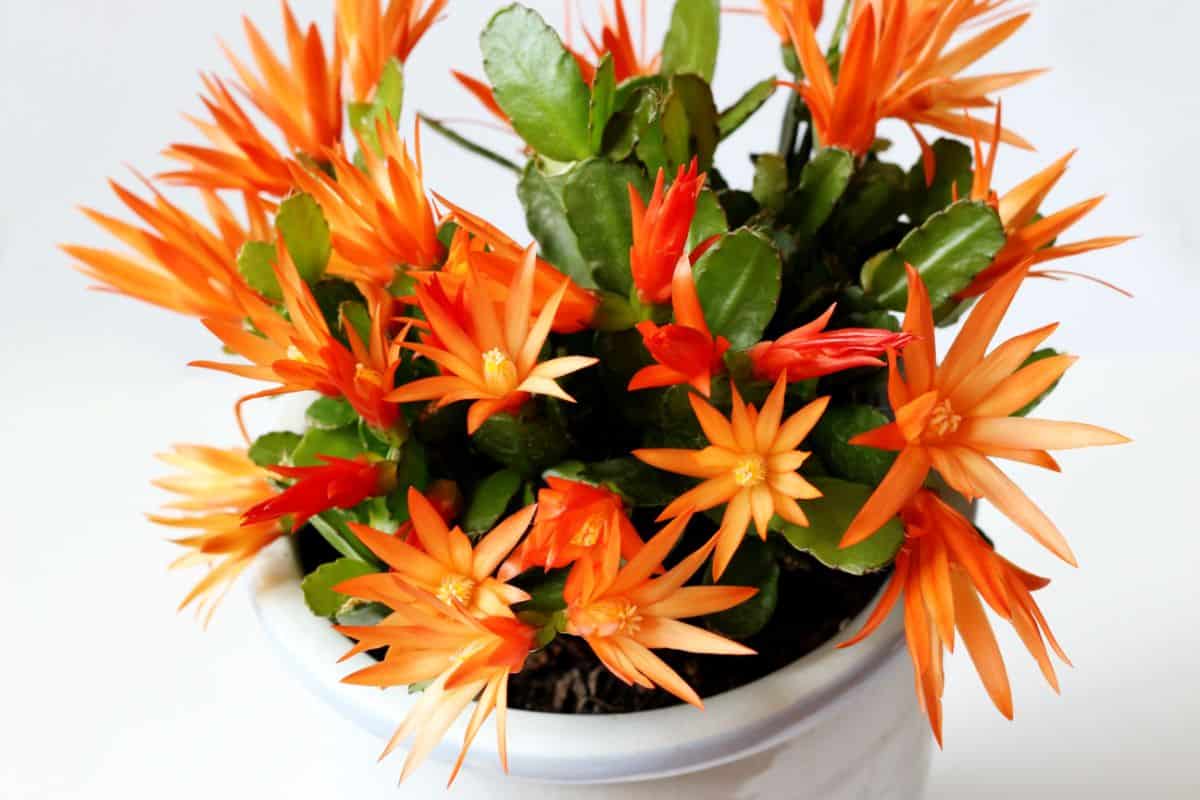
Buy it from:
The Colomba is definitely a succulent you want in your garden. They do well in pots as they can be a little finnicky with water. Their best feature is the stunning bright orange flowers. As most species in this genus, they have segmented leaves that can easily be propagated. The flowers often last for several weeks and they are nictinastic which means that the flowers open in the morning, and close at night.
Echeveria Agavoides – orange ebony
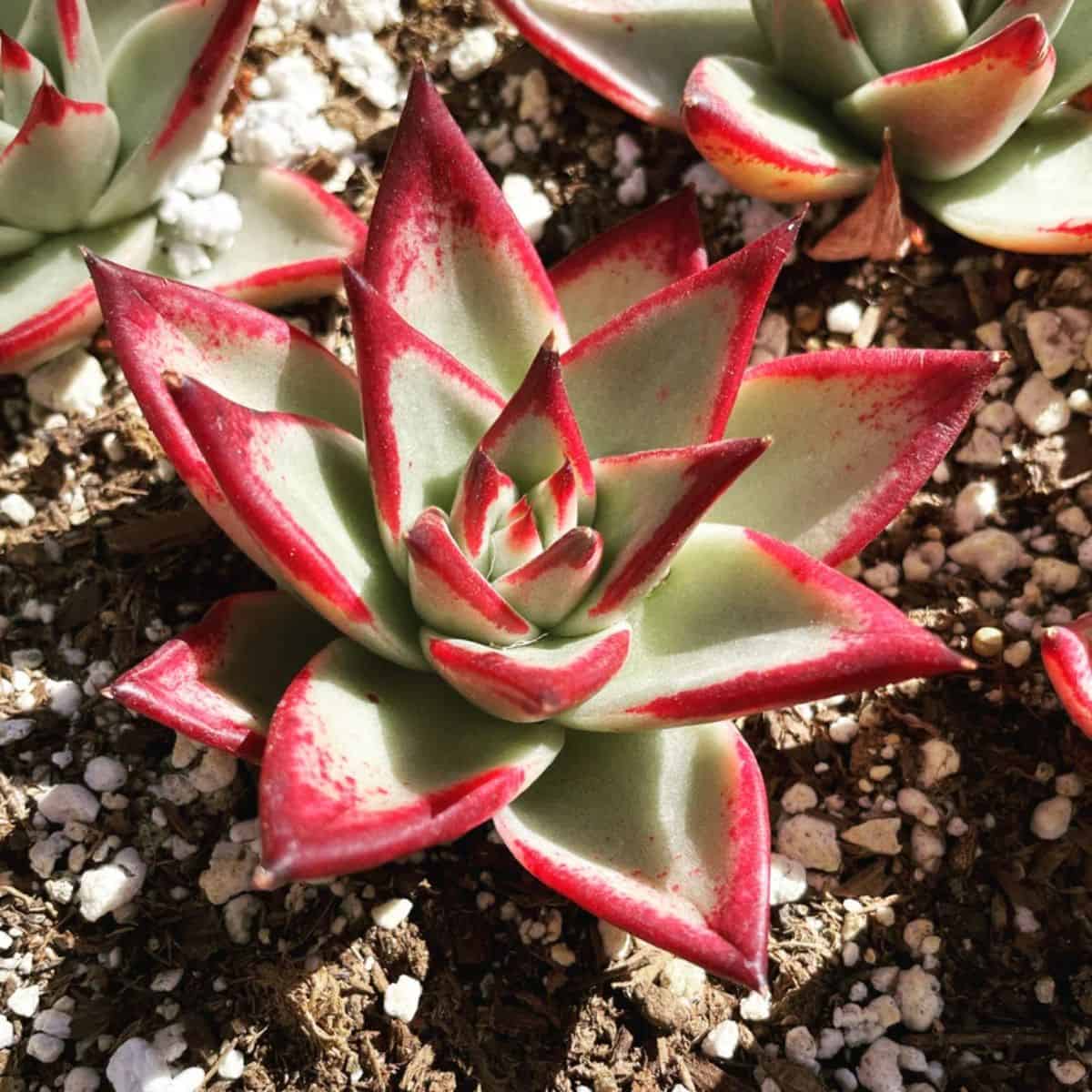
Buy it from:
Orange Ebony is striking show stealer. Under slight stress, they turn a magnificent bright orange with each leaf tipped in red. The base of each leaf is a light green and the center of Orange Ebony also stays a light green. Like most echeverias, they do well in full or partial sun and require minimal watering.
Haworthia obtusa - Orange
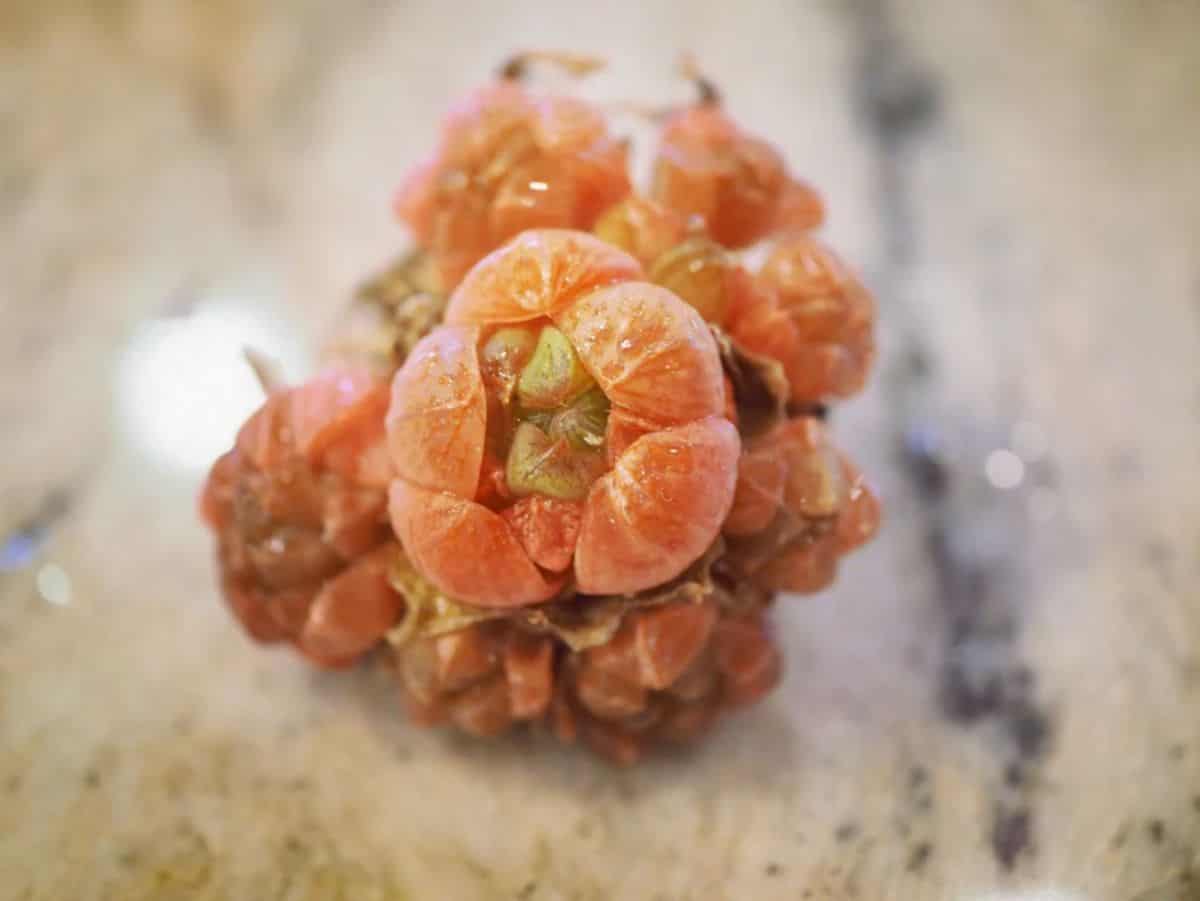
Buy it from:
Haworthia obtusa is a very particular species that responds very quickly to stress and the environment. When this variant is slightly stressed, the small clusters of translucent leaves take on an orange hue that makes each leaf look like a mini orangsicle!
One way to make sure that this haworthia maintains it’s color and stays healthy is by adjusting sunlight exposure as needed without causing the plant to burn. Most haworthias are used to growing in the shade or in dappled sun. Therefore, the easiest way to get them to keep their color is slightly stronger light.
Graptosedum Francesco Baldi
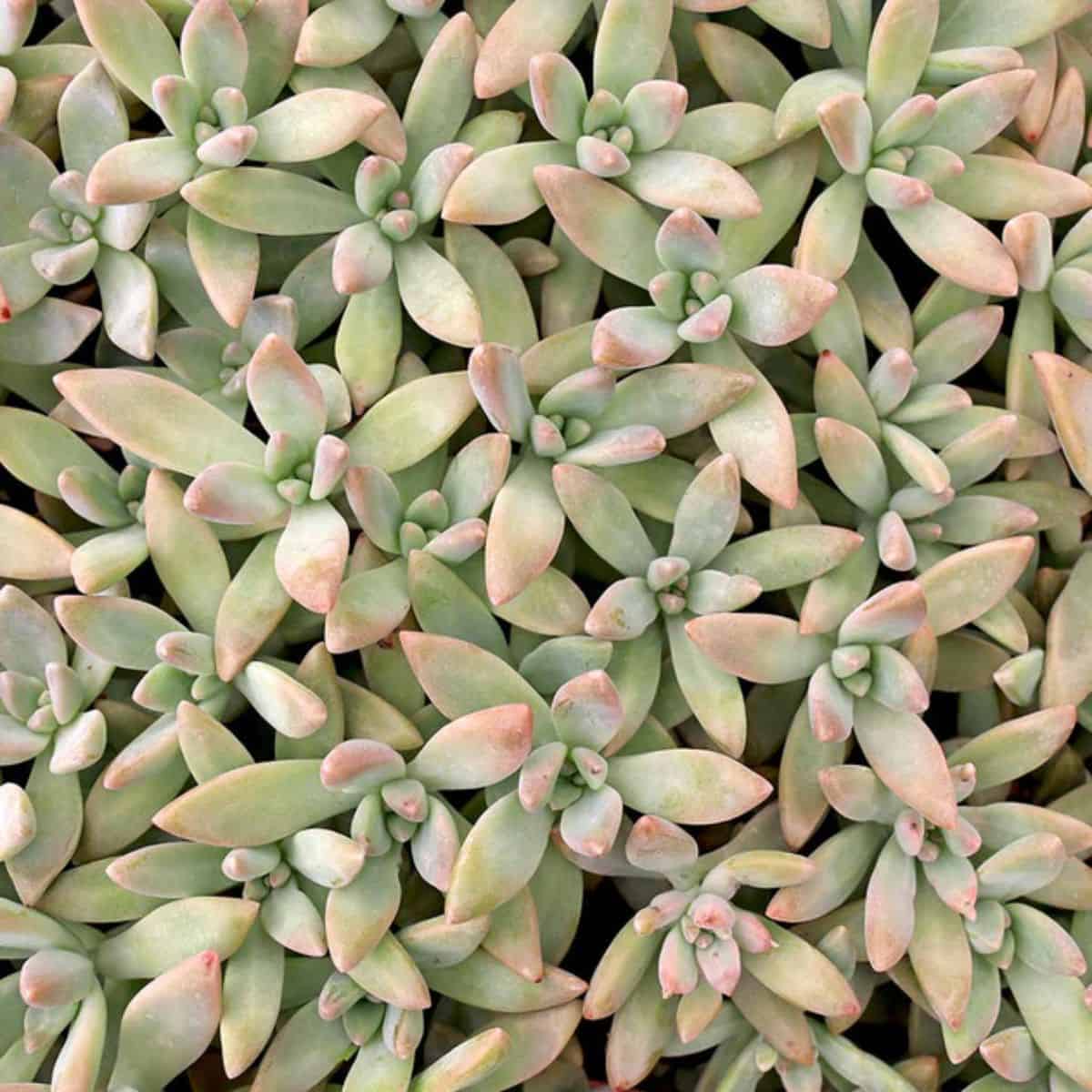
Buy it from:
If you want a succulent that will continue to impress year-round, then Francesco Baldi needs to be a part of your garden. This subspecies is generally greener in the summer months but as soon as the weather changes, the Francesco Baldi begins to take on startling pink and orange colors. The center of the succulent turns a light hazy pink and the ends of each oblong leaf begin to turn a perfect sunset orange. The orange may be hazy if your succulent is producing farina.
Euphorbia Tirucalli - “Sticks on Fire”
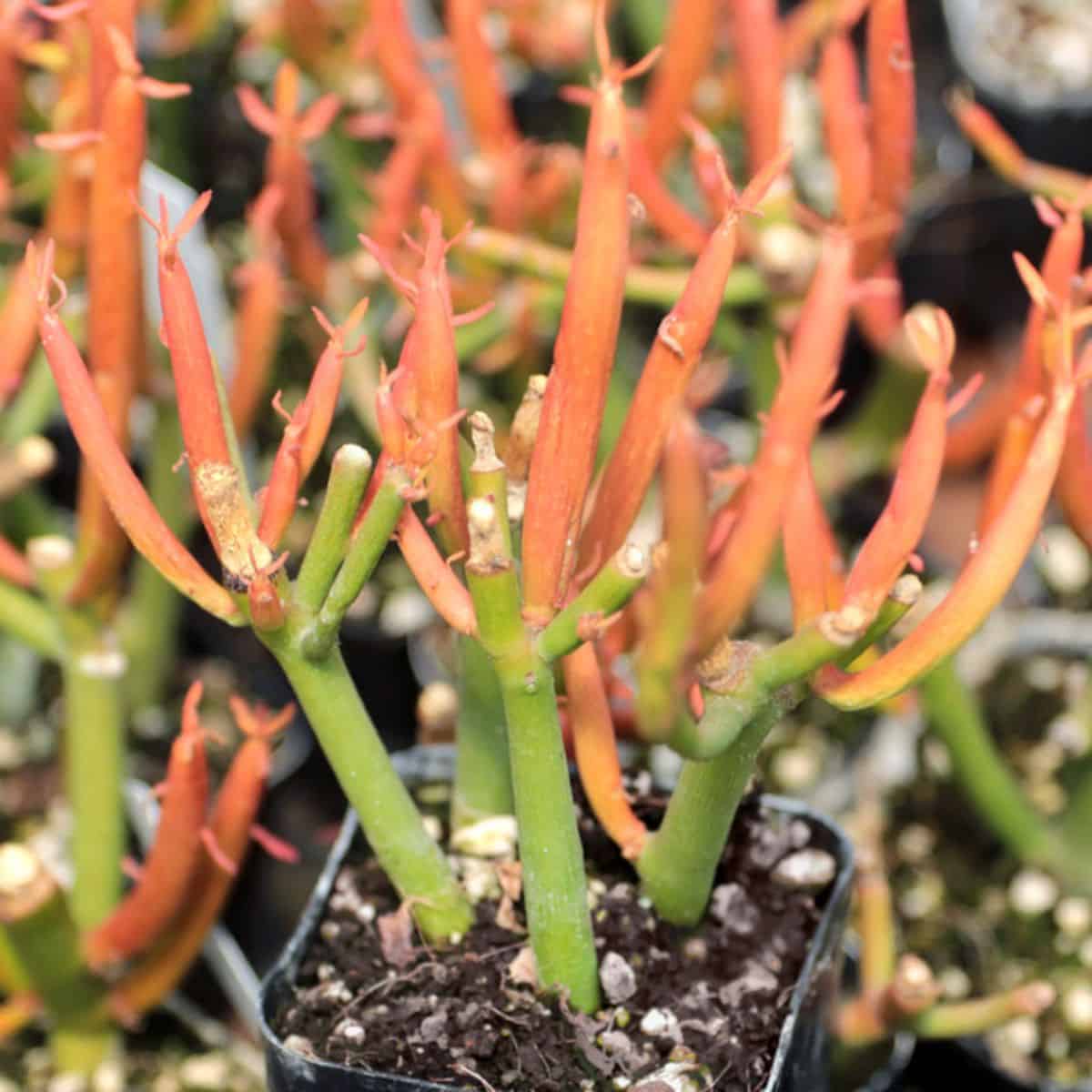
Buy it from:
Sticks on fire is considered a succulent shrub like several Jade types of succulents. In their natural environment, they can get up to 25 feet high and 8 – 10 feet in diameter. What sets this shrub apart, is that each pencil thin branch is a bright reddish orange.
This species prefers full sunlight and can be trimmed as needed to maintain a specific height. Fortunately, this shrub only gets about ten feet high in most gardens so maintenance should be low. They are very slow growers, but worth the time.
Echeveria “Snow Angel"
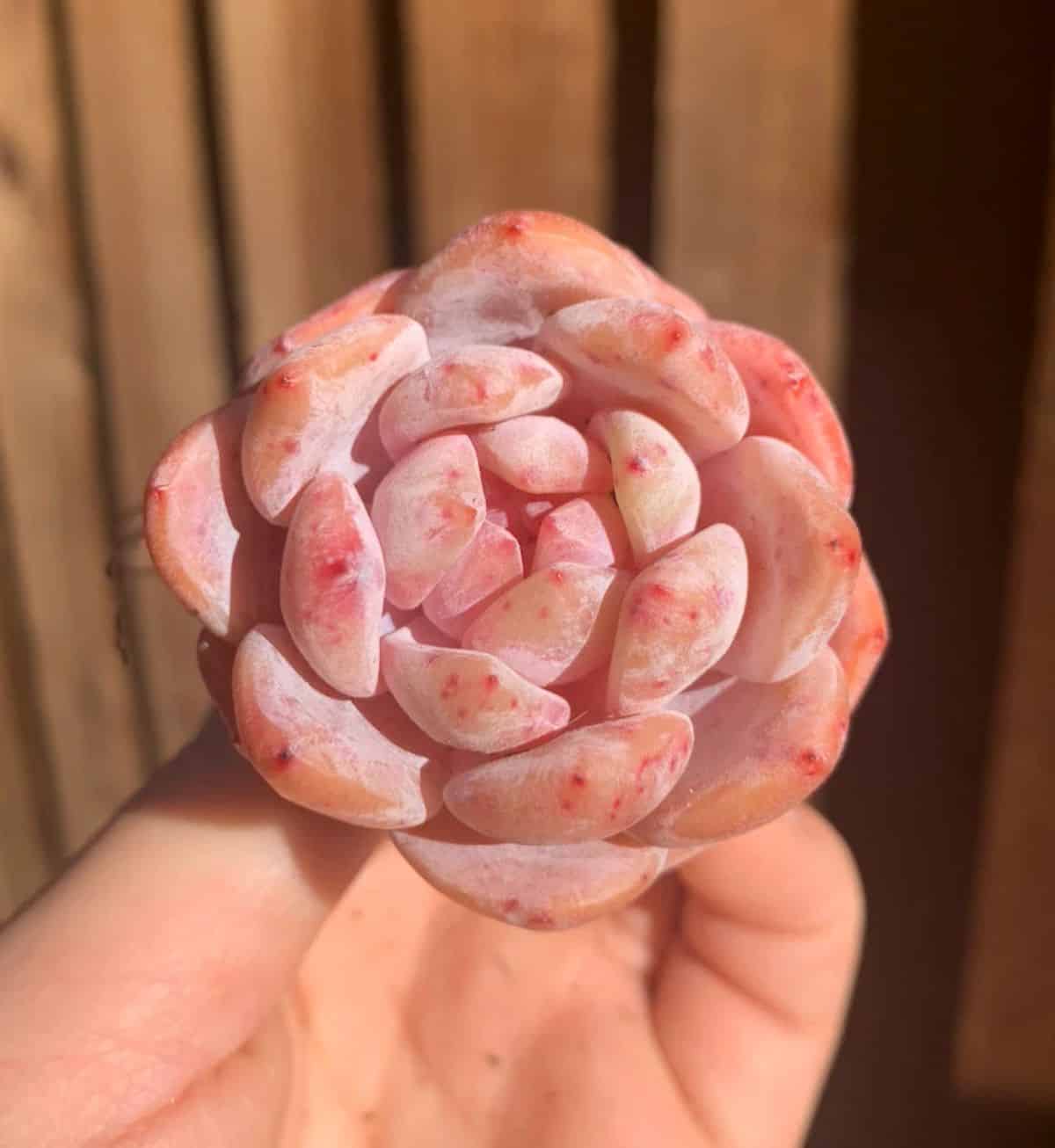
Buy it from:
The Snow Angel variant of echeverias is a dreamy pastel orange when weather changes or slight stress is introduced. Each bulbous leaf is entirely orange and may have a bit of farina which makes the leaves turn a slight hazy orange. They are a delicate and beautiful addition to a garden and would do well with any ethereal type of garden or as a contrast to spikier succulents.
Optuna phaeacantha hybrid - Orange Princess
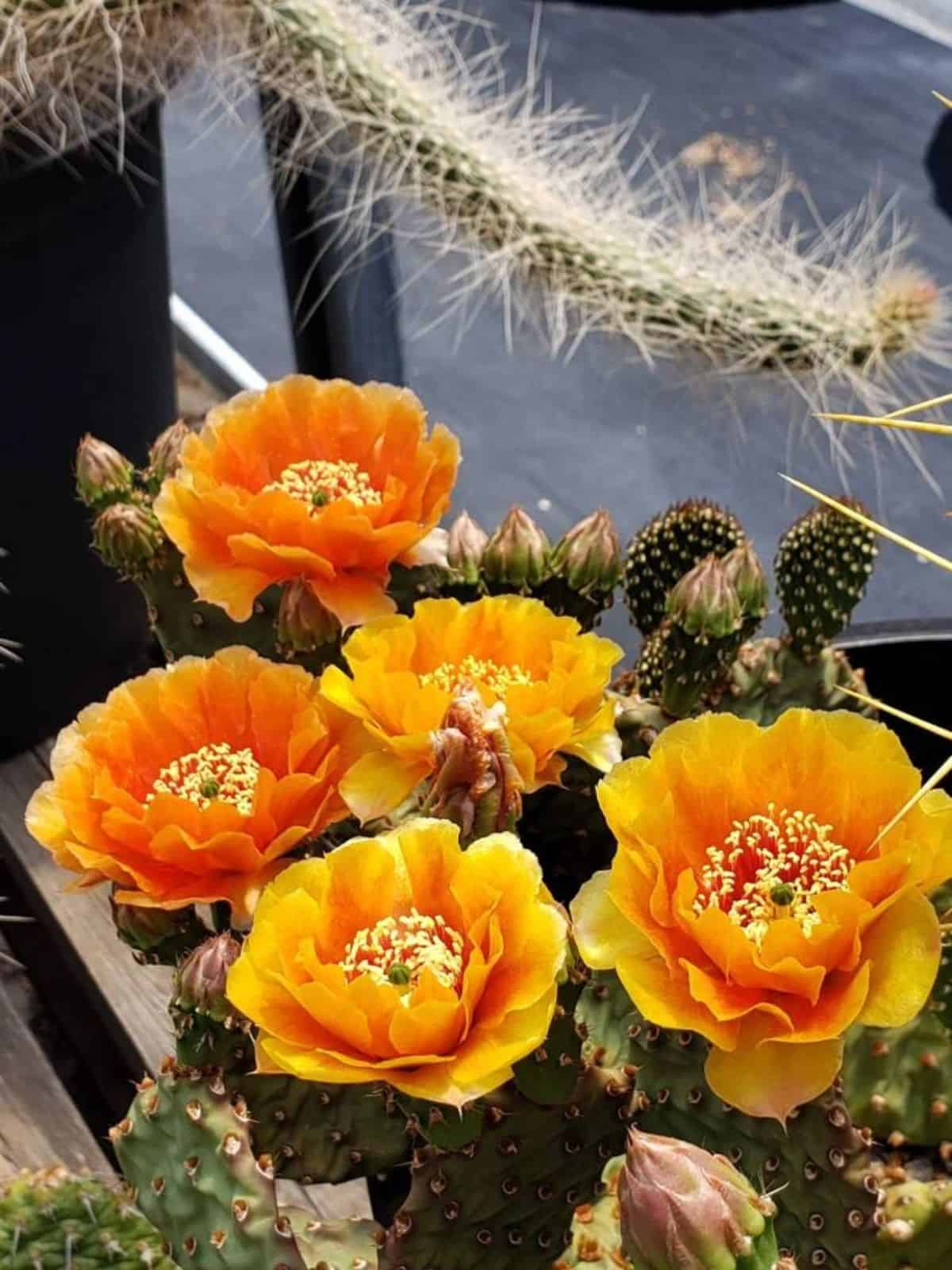
Buy it from:
Optunas are a type of paddle cactus that produce a wide variety of vibrant flowers. They are low growing but take up large swathes of area: their growth pattern generally leads to lush floors of succulent blooms. There are quite a few varieties with orange blooms, but the Orange Princess is probably the most intense orange bloom.
Crassula capitella - Campfire Crassula
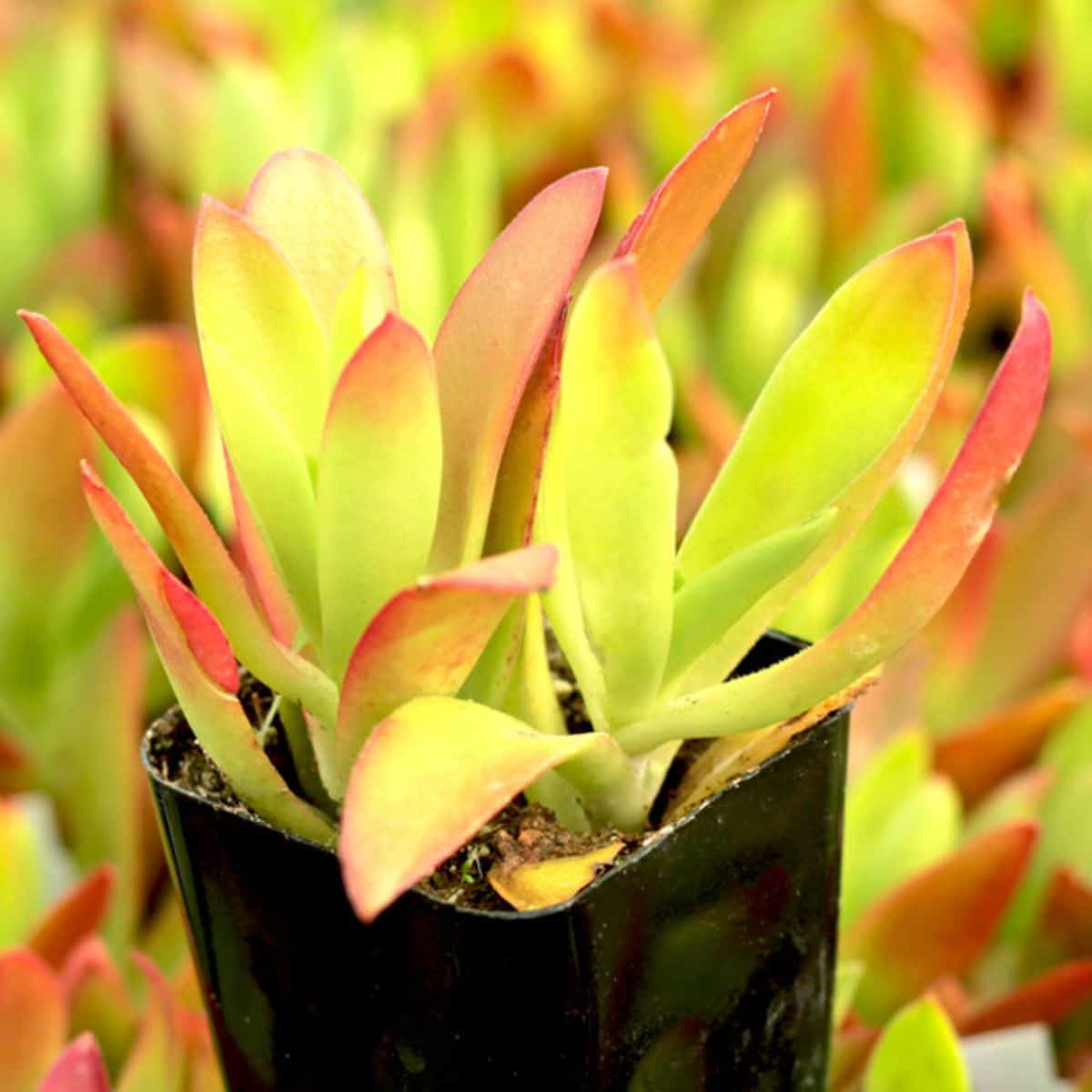
Buy it from:
Campfire Crassula is a steady orange succulent. The more basic variants are regularly light or lime green in the center with bright orange edges and, in some cases, a dark red outline along the leaf. The more intense varieties turn a deep orange without any green, and others have orange tips with green bases. The leaves are more oblong and pointed at the end, however they are characteristically full like many other crassulas.
Echeveria - Orange Dream
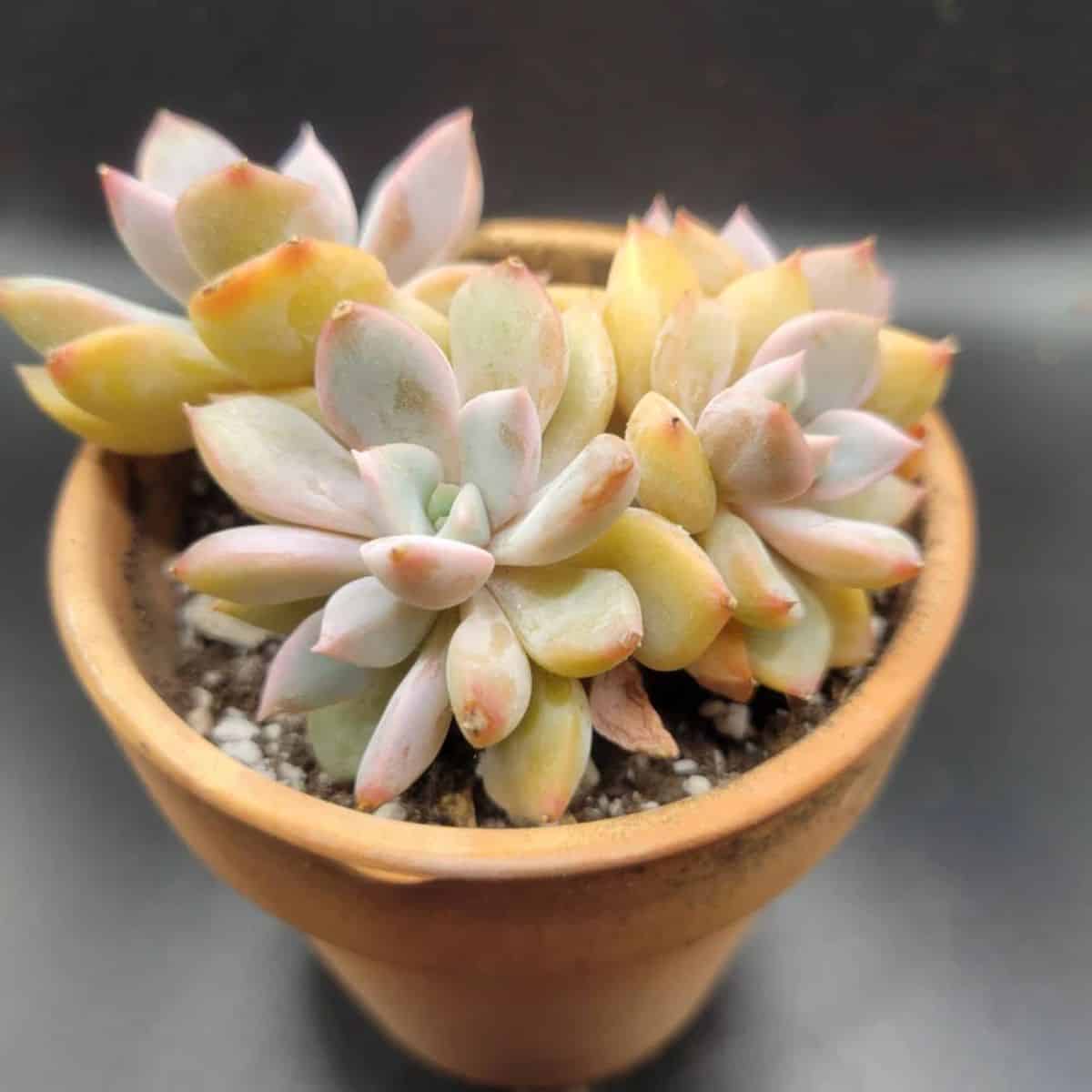
Buy it from:
The Orange Dream is a very pale orange, almost white echeveria. The leaves are almost like teardrops with very sharp points that can sometimes turn a bloody red. The ghostly Orange Dream is another great addition to any ghastly collection of succulents or as a single succulent in a decorative pot.
Haworthia bayeri SP Orange
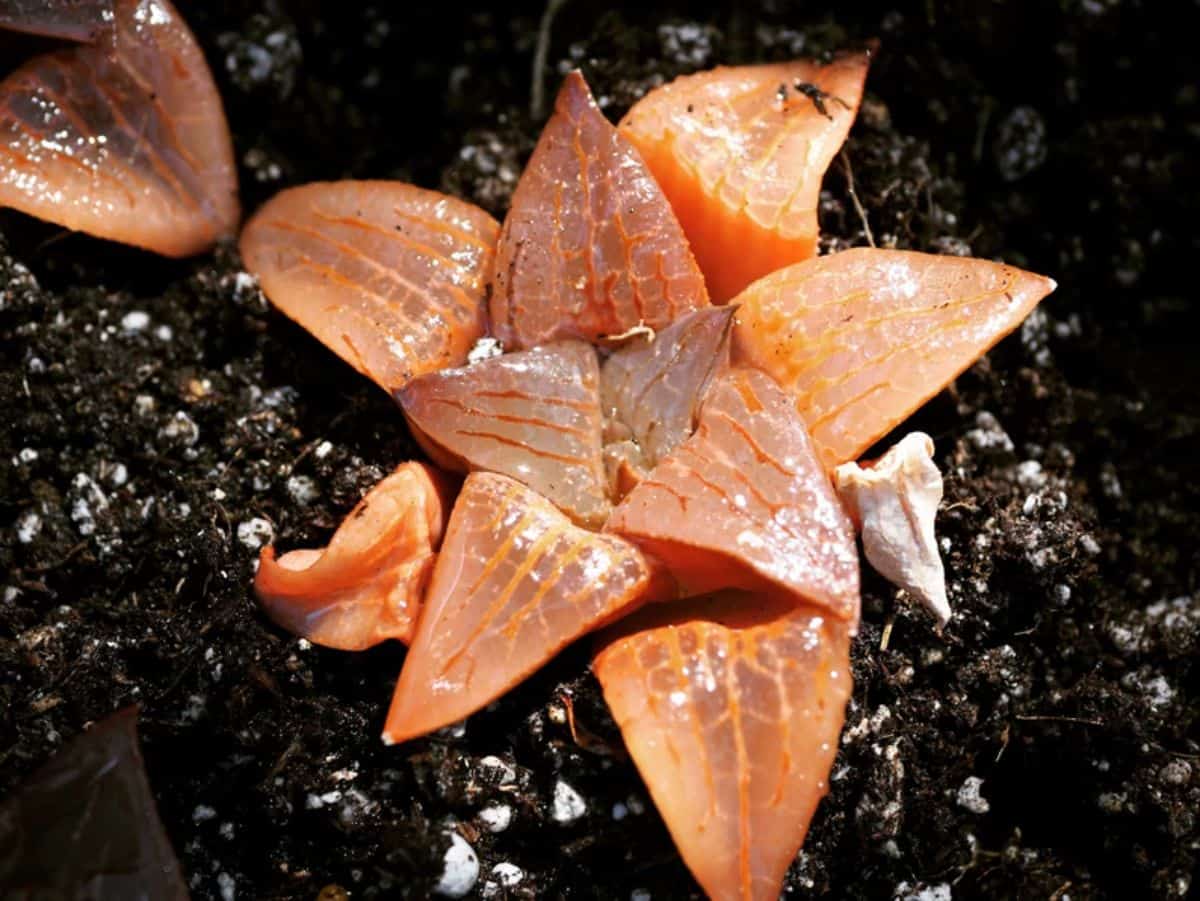
Buy it from:
If you thought there was only one kind of haworthia with a brilliant orange color, then this subspecies will surprise you! Unlike the rounded leaves of an obtuse, the bayeri species of haworthia has more pointed leaves that take on a triangular shape. The entire leaf turns a translucent orange that makes each leaf look like an orange icicle.
Aloe Dorothea – Sunset Aloe
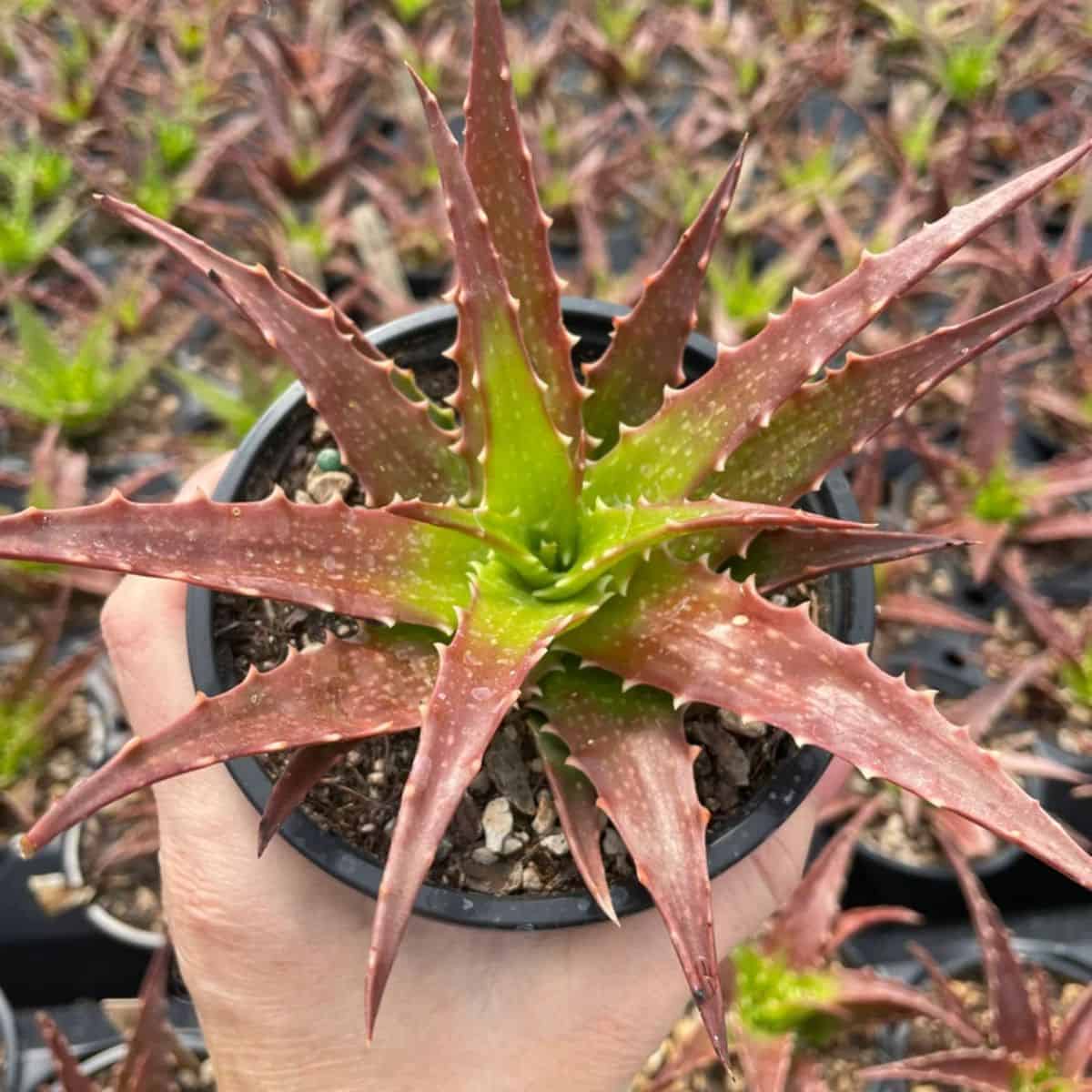
Buy it from:
This is a species that requires full sun in order for it to turn an intense orange red. The Sunset Aloe is a stunning plant that provides a literal burst of color in any garden. They are easy to take care of like many aloe plants. The biggest thing to watch for on these two-foot stars is going to be sunburn and providing enough water.
Echinopsis chamaecereus - Peanut cactus
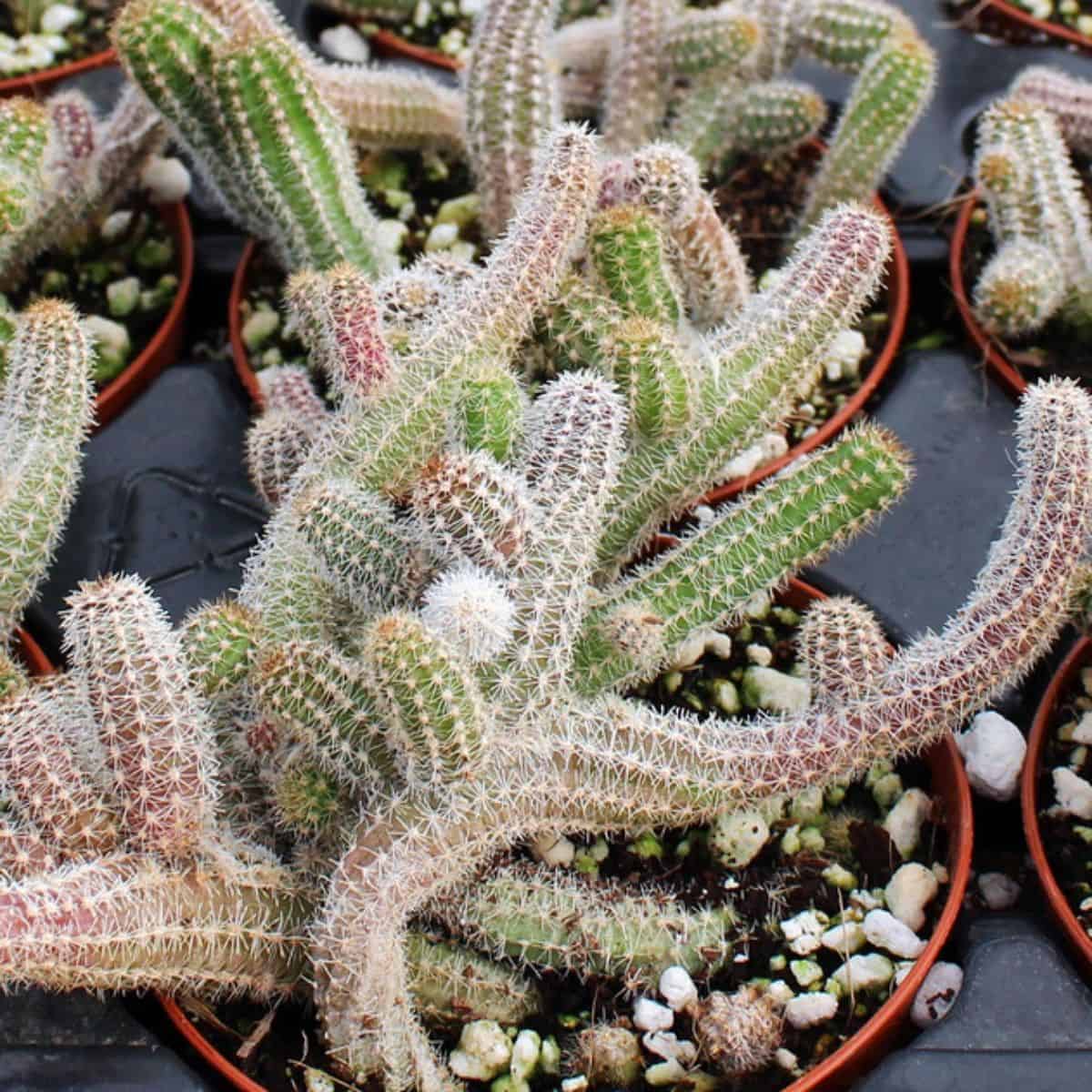
Buy it from:
Like the other cacti mentioned, the peanut cactus has a distinct halo of rusty orange that surrounds each column. It is aground covering type of cactus that has several fingers that get to an average of six inches high. They are rather easy to take care of and work well as a midground succulent.
Delosperma granita® - Orange Ice Plant
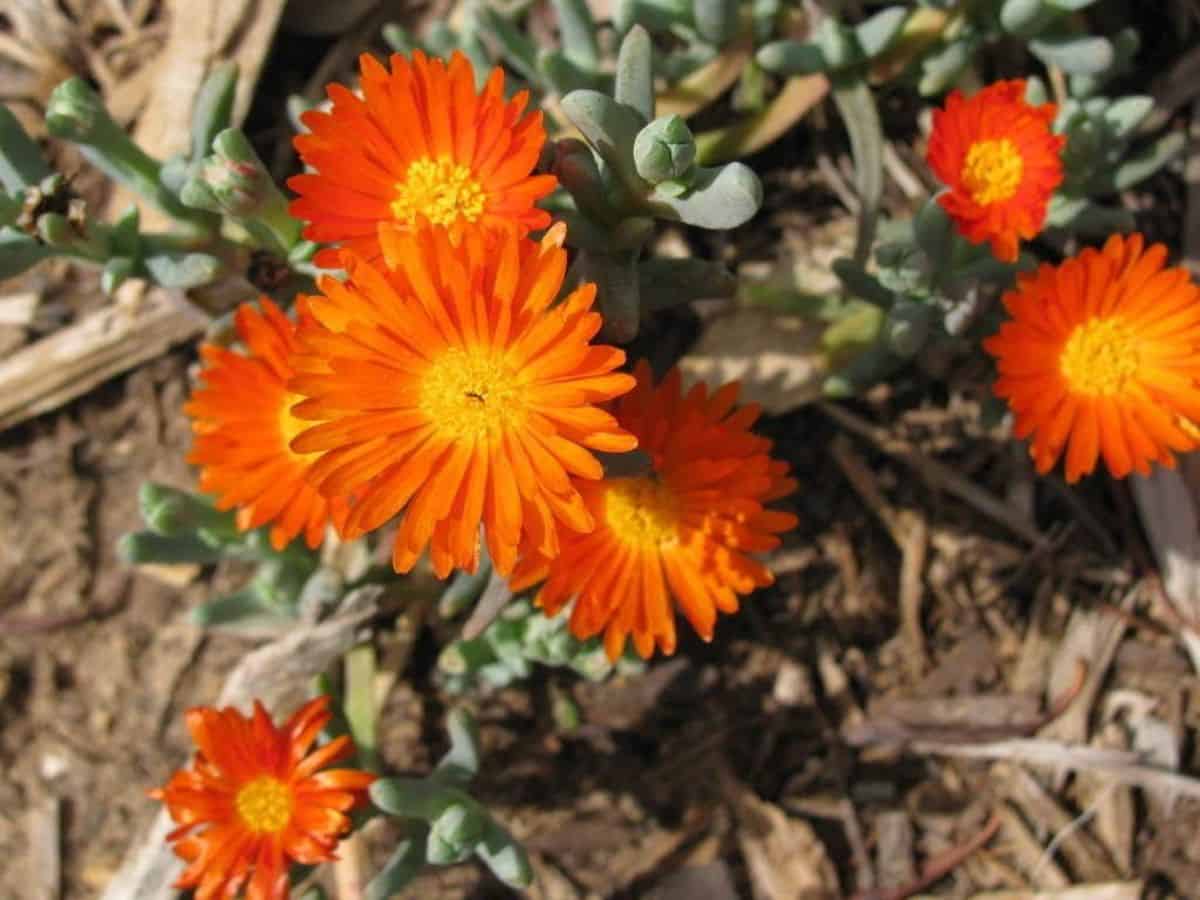
Buy it from:
As a designer succulent, the Orange Ice Plant is rather rare plant to get a hold of. They are provided only by specific nurseries because of their trademark. Like most ice plants, the orange variation does well at higher elevations that have higher rates of UV exposure. Orange Ice Plants shimmer like ice in the sun and so do the flowers. The bright orange daisy-like flowers create an intense blanket of orange during mid to late spring.
Kalanchoe blossfeldiana – Orange
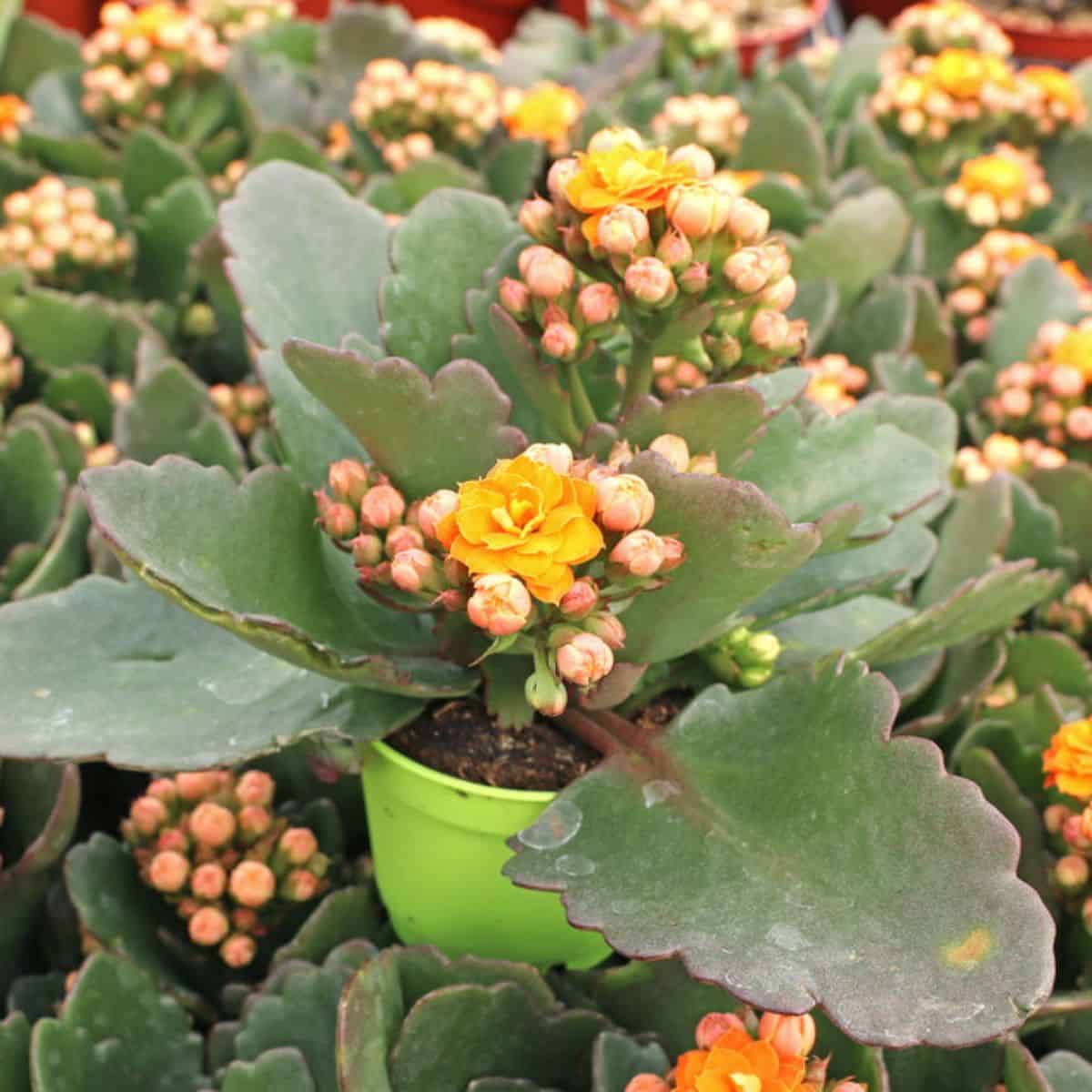
Buy it from:
Kalanchoes are slightly particular succulents that produce massive blooming stems that can last for nearly a month. Their leaves are evergreen and a little thick: they can be used as indicators of when it is time to water. All of the bloosfeldiana’s produce trumpet shaped flowers, but the colors an vary greatly from light pinks that appear during Valentine’s Day to the intense oranges during the Fall.
Graptopetalum mendozae – Ghost Plant
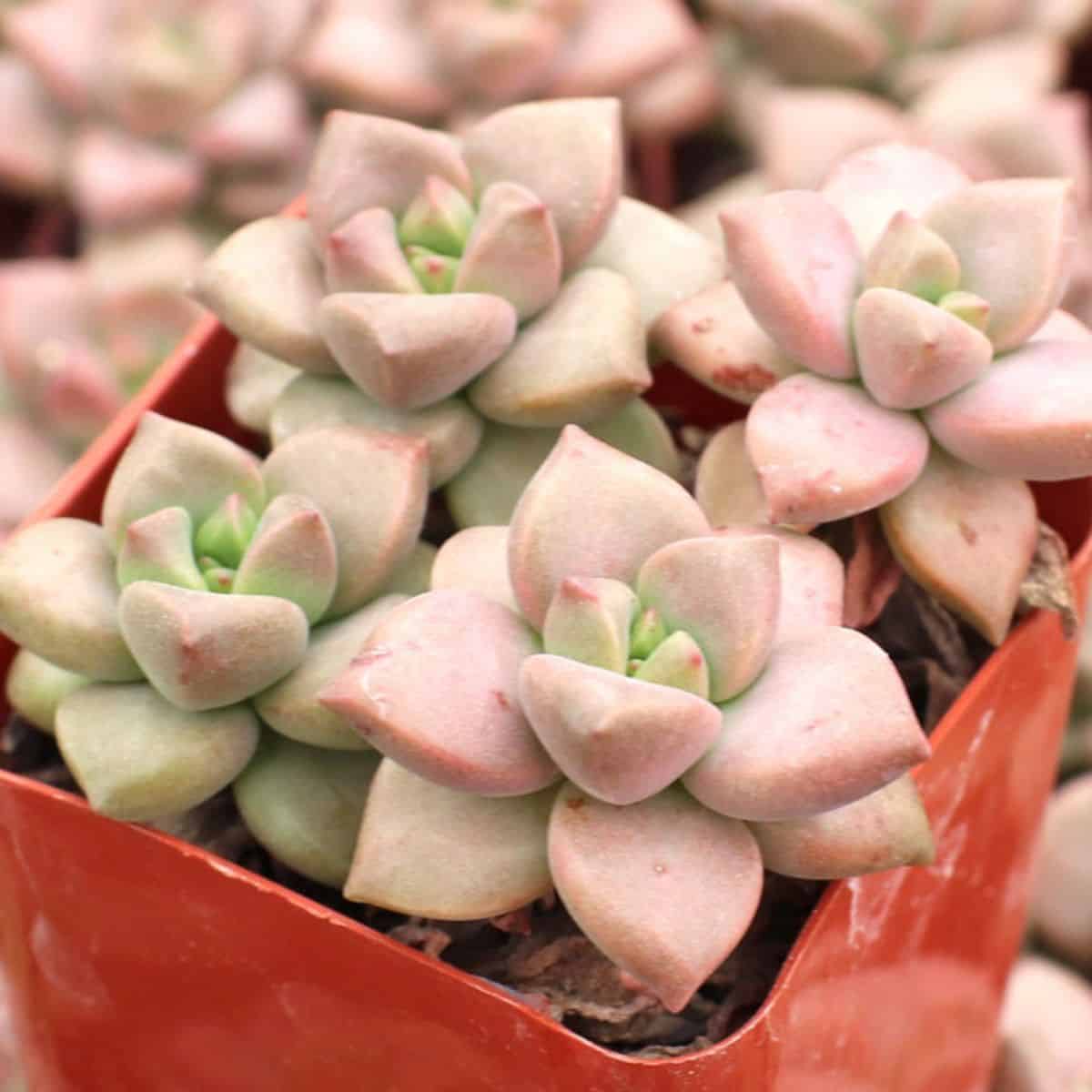
Buy it from:
One of my favorite photos of this species is a much older, sprawling plant in a pot that looks as though it is from the Yuan dynasty. The tiny, light orange rosettes pack tightly together along the stems and do well both inside and outside. Because they are so delicate, keeping them in full sun inside might be the better idea. They do turn greyish green during the summer months, but as the weather changes, they take on their characteristic orange color during the fall and winter months.
Aloe – Safari Orange
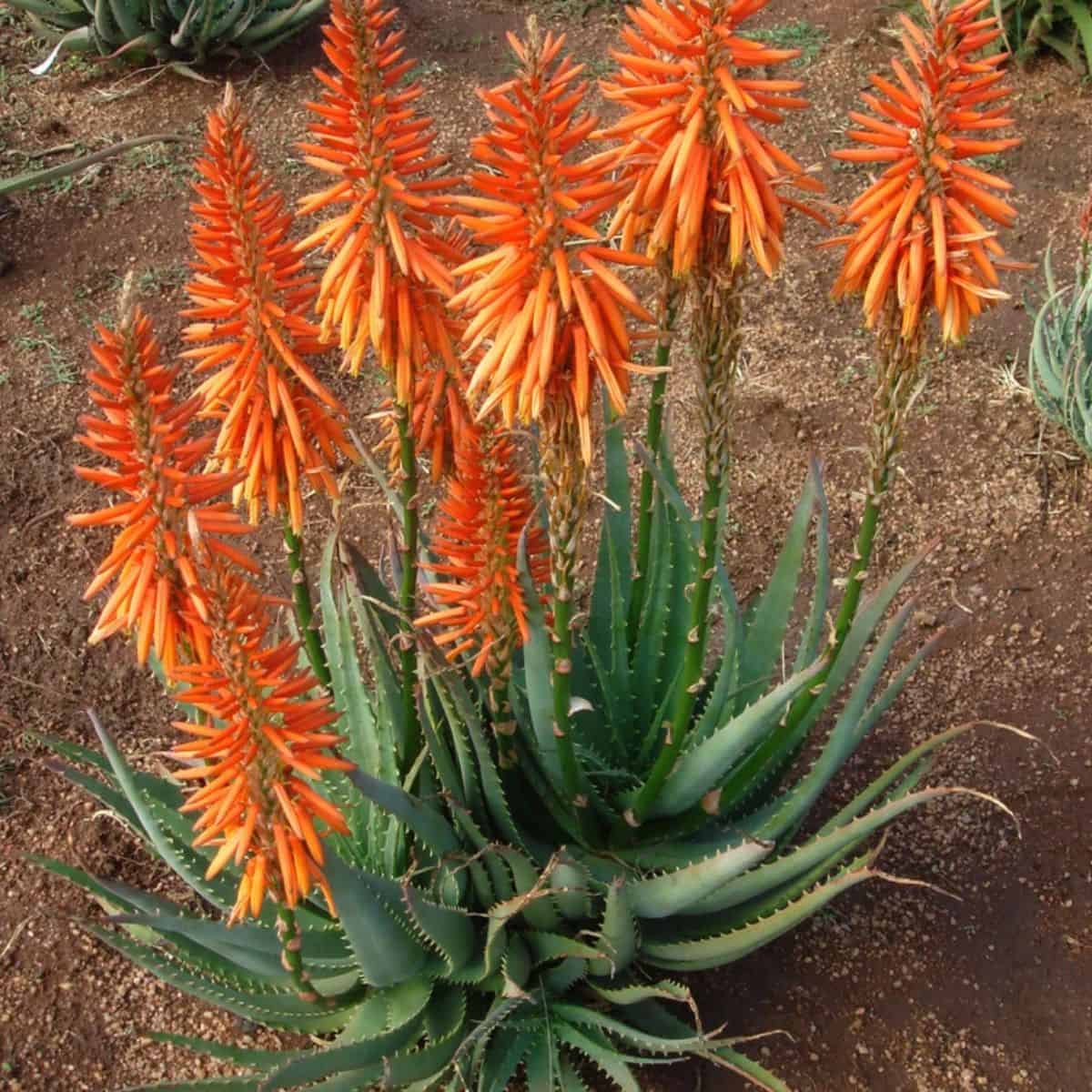
Buy it from:
This list must end with a bang and the Safari Orange is a perfect finale. This aloe does stay green; however, it produces massive blooming stalks full of trumpeted orange flowers. The reason that the Safari Orange is the best end is because it constantly produces flowers year-round! They are not cold hardy and will not produce during a freeze. Other than that, plant Safari Orange on it’s own or create a blanket of stunning aloe.
There’s nothing wrong with a garden full of green succulents, but if you’re looking to add a little panache to your collection, these orange succulents are just what you’ve been searching for. From pastel peach to vibrant sunset, there’s an orange succulent for every occasion. These gorgeous plants will make a statement anywhere you choose to plant them.

